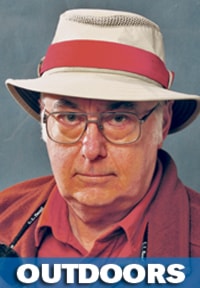The fly fishing fad inspired by “that movie” seems to be fading away. I am hearing frequently from surviving beginners who have hung in there that it isn’t as easy as it looked in 1992’s A River Runs Through It, and asking for suggestions to help them become better at the recreation.
Areas of interest for more learning from the people I hear from almost always start with casting. More than 50 years ago, I learned the basic overhead cast, the roll cast and various other fly fishing basics at the free annual May school offered by Builder’s Hardware and its sporting goods manager, the late Cec Grove, then the only fly fishing school available in Alberta.
Now there are more schools, and they may be the best way to deal with casting matters, especially if the teachers are certified fly casting instructors, as are Jim and Lynda McLennan, who offer schools, clinics and other events. In addition, Jim has been a professional fishing guide, a tackle dealer and a fly fishing author.
Jim says that their “beyond the basics” schools are popular with fishermen who want to get better at all aspects of the sport. Interested anglers should go to the website www.mclennanflyfishing.com and check out the many offerings under the category “Intermediate Schools.”
When I felt a dire need to get much better at a recreation I loved 45 years ago, I put myself in the hands of several professional fishing guides in Montana. That was radical then, because of “the real men don’t need guides” syndrome that persists in Alberta to this day.
I always started by telling every one of them that they should feel free to make suggestions and help me become a better fly fisherman, and was rewarded with some superb instruction, trips, hints and help, not to mention their friendship. In that friendship category are two superb teaching fishing guides in the Red Deer area: Garry Pierce of Tailwater Drifters and Dwayne Schafers of Easyway Drifters.
Part of being a true professional is that you get paid for what you do, and some of my supplicants for suggestions on how to improve their fly fishing feel they can’t afford guides or schools “at this time.”
That leaves books, which can be helpful, but only if you have progressed enough to understand what they are telling you. To help you decide if you’re ready to move on, a must-study is The Curtis Creek Manifesto, by Sheridan Anderson, actually a quirky, funny, but many-edition classic comic book that is a superb undergraduate textbook in itself for fly fishermen of all ages.
It is hard to learn to cast from a book, even though, in the olden days, fly casting teachers erroneously made you hold a tome between casting elbow and body. But the textbook for post-graduate home study in casting should be Lefty Kreh’s Ultimate Guide to Fly Fishing. Lefty is an awe-inspiring fly caster and casting teacher. He also has ingenious and practical solutions for most fly fishing problems derived from his seven decades of fishing everywhere in the world.
After casting, the “newbies” want to learn more about the “bugs,” aquatic entomology, hatches, fly tying and stream craft, the advanced tricks of the trade.
Books and onstream study are the best solution for problems with identifying and timing aquatic insect hatches. I’m not telling you, but many other fly fishermen tell me that the most practical book for identifying the important fly hatches and predicting when they occur is my own The Phenological Fly, unfortunately hard to get and very expensive on the rare book market, but I’m working on it.
While we wait, I can tell you that the book that helped me write my book is The Complete Book of Western Hatches, by Rick Hafele and Dave Hughes.
In the absence of fly fishing clubs, Trout Unlimited chapters and community fly fishing courses like we have today, I was able to teach myself to tie effective flies solely from the amazing photographs and succinct instructions for the use of most standard materials in Fly Tying, by Helen Shaw.
The very best, the absolute masters, the PhDs of fly fishing know when, where and how to break the rules. There are a very precious few books on radical, rule-breaking methods. West Yellowstone author Charlie Brooks is a must, especially his Larger Trout for the Western Fly Fisherman. From it I learned the importance of fishing imitations of the largest stonefly nymphs and how to get them deep down where the naturals live.
In his Modern Dry Fly Code, Vincent Marinaro convinces us of the importance and how-to of fishing imitations of “terrestrials,” land-based insects.
Leonard M. Wright Jr. is the dean of the unusual methods school, as the titles of some of his books make clear: Fly-Fishing Heresies, Trout Maverick and Fishing the Dry Fly as a Living Insect.
Bob Scammell is an award-winning columnist who lives in Red Deer. He can be reached at bscam@telusplanet.net.
